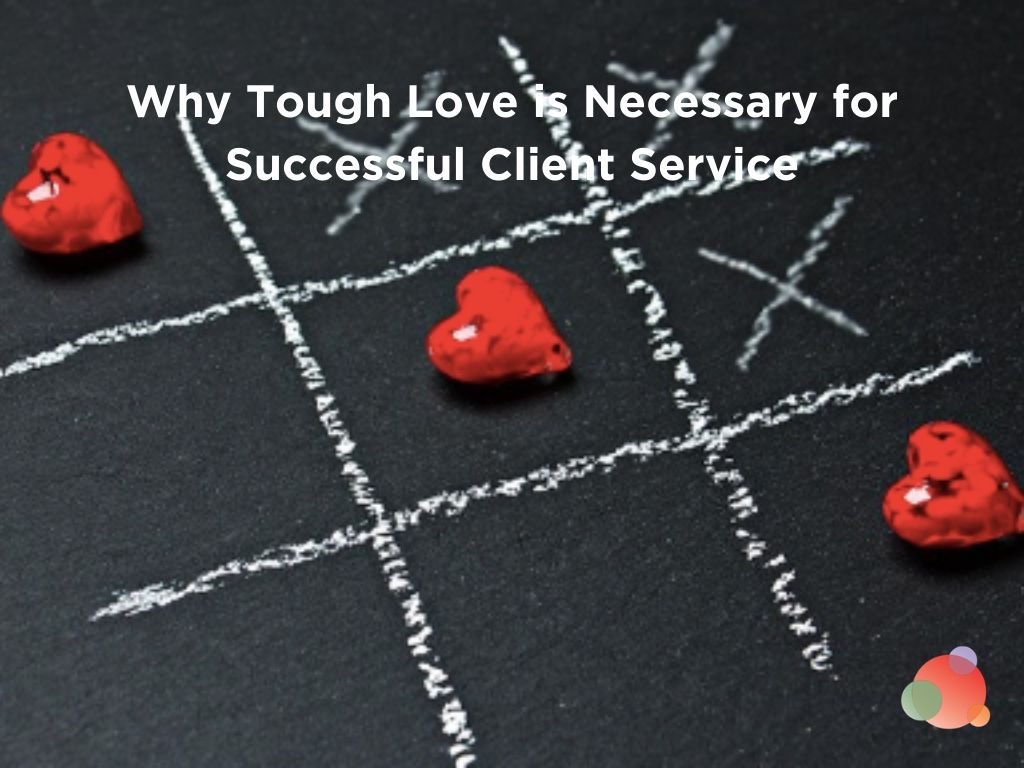
Tough love is an important element of any relationship.
After all, if you can’t count on the ones you love to tell it like it is, who can you count on?
The same holds true for our relationships with clients.
It is our job to tell clients where there is room for improvement within their organization.
It’s also our job to tell them “no” when they are heading down the wrong path or distracted by an idea that doesn’t support their goals.
We must guide them in the creation of the most optimal situation for their business as a whole (including their communications programs).
That’s a win/win for everyone.
But that doesn’t mean it’s easy.
Telling clients things they don’t want to hear isn’t fun.
And it requires four very important elements:
- A trusting relationship
- Good communications skills
- A comprehensive understanding of their business and industry
- A solution-focused message strategy
So let’s talk about where tough love fits into each.
Client Service and Trust
It will come as no surprise to anyone the number one element of a successful client service relationship is trust.
If your client doesn’t trust you, and vice-versa, there really isn’t a foundation for a productive partnership.
You have to earn your client’s trust through your communication and your action.
From the beginning of our client relationships we make sure we:
- Set expectations. So clients know what to expect, when to expect it, and what our process is.
- Are completely transparent. This applies to process, timeline, measurement, and both successes and failures. We speak directly to what we are doing and why, follow it up with measurement and success metrics, and proactively address when we make a mistake or are not meeting our goals for one reason or another.
- Communicate openly. We create an atmosphere where we can have an open and honest dialogue with our clients, and encourage them to do the same with us. We never want to have a client stop working with us and hear after the fact they did so because of a situation that could have been resolved when it first developed. This type of open communication is key for long-term successful relationships.
Good Communications Skills Aren’t Implied
Communications pros often assume that because they work in communication they are good communicators.
This is false.
You might be skilled at communications strategy, fantastic at social media campaign execution, and write content like a pro.
None of this means you are a good communicator.
In fact, some of the worst communicators I’ve ever met work in communications.
The awkward thing is often the worst communicators think they are the best.
Which is probably why they are so bad.
They lack the self-awareness to take responsibility for how their words affect those around them.
Oh, and they don’t listen.
My best advice is to constantly work to hone your communications skills.
This includes everything from the words you use to your awareness of bias.
Study it like you would any other skill and work to improve daily.
You can never, ever, ever, ever be a good enough communicator.
You can always be better.
Client Service Requires 360 Vision
You can’t service your client productively, nor speak to their opportunities or weaknesses, if you don’t understand their entire business and the industry they operate in.
This also means you must act as if you are an internal team member.
You need to know at least as much about the organization and the industry as any team member working inside the organization—and often more.
Otherwise, you are unable to identify or correct issues that stunt growth.
Nor can you understand nuance or be aware of specific language and context that’s important when communicating.
My guess is about 90% of the problems that prevent you from maximizing the success of your communication program occur outside the communications department.
But you won’t know that if you don’t have a comprehensive view of the ecosystem.
Solutions Are the Heartbeat of Client Service
And that brings us the final criteria needed: solution-focused communication.
When you go to a client with a problem, you need to accompany that with a solution.
That’s part of your job.
You must identify issues and support solutions.
Now the best way forward might not be totally in your control.
You may not even have enough information at first to offer a complete response.
But you need to support the process of resolution.
To do this, ask the right questions and lead a productive discussion around the issue.
Bring problems to clients.
Tell them when they are doing something that’s hurting their goals.
Tell them no.
Be transparent in areas where the organization needs to improve.
And do so in a solution-minded way.
That’s how you practice tough love.
(P.S. these same rules apply internally in your organization as well.)
How Do You Practice Tough Love In Client Service?
What strategies would you add?
How do you say no to clients?
Or decide which battles to fight and which to let go?
How do you help reroute clients when they start to go down the wrong path?
Share your ideas in the comments.